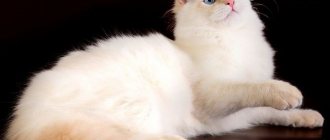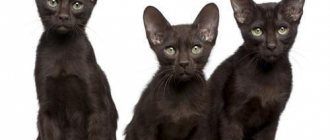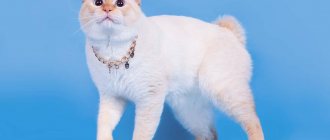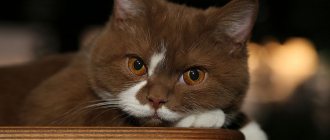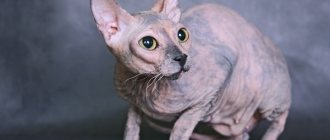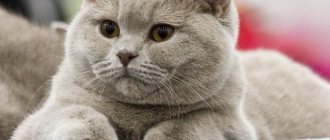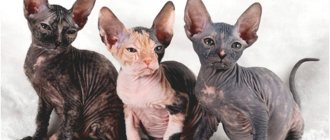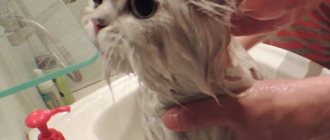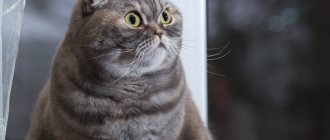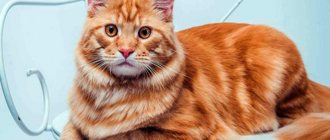Origin of the brindle breed
Tiger cats are a whole genus that includes various breeds. In nature they are predators.
Despite their Latin name (Leopardus), they are not related to leopards.
All representatives of the genus live in the wild in Central and South America. The exact date of origin is unknown, but these representatives of the cat family have existed for a very long time.
Tiger cat
For reference! Until recently, all animals of the genus were purebred, but now hybrid forms are being bred.
Types of tabby colors
There are four Tabby patterns that have been shown to be genetically distinct: Mackerel, Classic, Spotted and Ticked.
The fifth pattern includes Tabby as part of another primary color pattern. A patched tabby is a calico or tortoiseshell cat with multi-colored patches (also known as caliby and torbie, respectively).
All of these patterns were found in randomly bred populations. Several additional patterns of this color are found in certain breeds, for example, a modified classic Tabby is seen in the Sokoke. Some of them are associated with the interaction of wild and domestic genes. Rosette and marble patterns are characteristic of the Bengal breed.
Sokoke
Silver Bengal
Thus, even a shallow study of genetic inheritance makes it possible to assume that there are many types of Tabby colors, but the most common of them are the following:
- brindle;
- marble;
- spotted;
- ticked;
- tortoiseshell.
Spotted Tabby
Spotted minke whales have linear markers in their color, divided into spots, which can be located vertically or horizontally. A 2010 study suggests that spotting is caused by modification of mackerel stripes and can cause different phenotypes, such as "broken-type" stripes, through multiple loci.
Ticked Tabby or the T allele usually results in a non-patterned agouti tabby with virtually no stripes or lines.
The stripes often remain to some extent on the face, tail, limbs, and sometimes on the chest in heterozygotes and almost none in homozygotes. Ultimately, the dominant tabby allele is dominant and therefore completely (or mostly) masks all other tabby alleles, hiding other patterns.
Spotted Striped Tabby is a modifier that breaks up the Tabby Mackerel pattern so that the stripes appear as spots. Likewise, the stripes of a classic striped pattern can be broken up into larger spots.
This color can be seen in the Australian Mist, Bengal, Serengeti, Savannah, Egyptian Mau, Arabian Mau, Maine Coon and Ocicat.
Australian mist
brindle tabby
The Ticked (or Stripeless) pattern creates agouti hair, strands of hair with distinct stripes of color, breaking up tabby patterns into “salt and pepper” or “sand.” Residual stripes or "medallions" can often be seen on the lower legs, face and belly, and sometimes at the tip of the tail, as well as a long dark line running along the back, usually along the spine.
A striking representative of this color is the Toyger, a breed that appeared on the basis of the Bengal.
Little Toyger
Mackerel tabby
The Mackerel pattern (often called "Striped Mackerel" in foreign sources) has vertical, slightly curved stripes on the sides of the body. They are narrow and can be continuous or broken into sections and spots on the body and belly.
The "M" mark appears on the forehead along with dark lines on the cat's cheeks and at the corners of her eyes. "Mackerels" are also called "fish seals" and are the most common tabby pattern.
Classic tabby
Classic (also known as "Spotted" or "Marble") Tabby typically has patterns of dark brown, ocher and black, but also comes in all colors except white. These animals are sure to have an "M" mark on the forehead, and the body marking is a swirling or spiral pattern (often called a "bull's-eye") on the sides of the cat.
There is also a light butterfly marker on the shoulders and three thin stripes (the central one is dark) running along the spine. Like Tabby Mackerel, Classic Mackerel have dark lines on the legs, tail and cheekbones.
Name of the breed
Brindle cat breeds differ from each other in a number of characteristics. They are united by color, character and life expectancy, but there are still differences.
Toyger
Spotted cat - examples of breeds and their names
Toyger is a miniature tiger cat. It is not for nothing that the translation of the name of the breed from English is toy tiger. Among all representatives of tiger cats, this one has the most pronounced color.
For reference! The cost of Toyger tiger kittens is very high, since they are considered exclusive.
In some nurseries, queues are formed to obtain purebred Toygers.
Breed Features:
- large powerful body, the weight of an adult animal reaches 8 kg;
- legs are short;
- the tail is thin and long;
- powerful neck:
- large bright blue eyes;
- short soft wool.
The color of the stripes varies - it can be black, yellow and brown. The tip of the tail and paws are always black. The cat's character is soft and calm, she loves care and attention. Kittens are playful, but adult animals are calm, serious and very loyal. They are distinguished by their love for children.
These cats live quite a long time - up to 20 years.
Interesting! Toygers not only meow, but also make other sounds similar to bird chirping.
Toyger breed
Asian Tabby
The Asian Tabby has the following characteristics:
- cat size up to 7 kg;
- the body is powerful, strong, with well-developed muscles;
- the tail is thin, straight, long, ending in a tassel;
- the head is short, dense, with large almond-shaped or rounded yellow eyes (shades of color can vary greatly, amber color is especially fascinating);
- the wool is thin and soft with a variety of colors.
The color of the coat varies, but has a particularly attractive pattern, combining patterns of spots and stripes.
Depending on the pattern there are:
- spotted tabby - spots of different sizes and colors are scattered throughout her body;
- marbled tabby - the color of the skin resembles marble with its unusual, intricate combination of spots and lines;
- brindle tabby - a real tigress with corresponding stripes on her light skin;
- ticked - monochromatic wool, but each of its hairs is painted in two colors at once - light at the base and dark at the top.
Asian brindle tabby
Bengal
The Bengal cat is a rare breed, which, however, is of artificial origin. Her parents were a leopard cat and domestic cats.
The breed was officially registered in 1983, 20 years after its breeding. During the work on Bengal cats, leopard spots turned out to be chaotically scattered throughout the body, and their color may vary.
The main colors of the spots are black and brown, but there can be any other shades. Bengal cats are a fairly rare breed, but they are more common than cats with the tiger color - Toygers.
These pussies are not afraid of water; on the contrary, sometimes they can organize mini-swims in the pool or bathtub. And one more interesting feature: before drinking water from a bowl, they run their paw over its surface, as if driving away mud.
This is interesting! Bengals do not meow, but make rare short sounds that are something between a meow and a growl.
Bengal cat
Oncilla
This tiger cat still exists in the wild. Oncilla is larger in comparison with domestic representatives of the genus, but compared to its wild relatives it is the smallest.
Breed characteristics:
- the coat is yellow-gray striped, short;
- Habitat: humid tropics;
- an adult oncilla is indistinguishable from a jaguar kitten in appearance.
Due to its resemblance to a jaguar, as well as the presence of a beautiful soft coat, this breed is on the verge of extinction. Poachers are constantly hunting for wild tiger cats. Hunting for them is strictly prohibited. Her character is very capricious, so keeping the beauty at home is not recommended.
Interesting! Oncilla is not only not afraid of water, but also swims beautifully.
Tiger cub oncilla
And others
Other breeds of tiger cats are less common than those represented. These are the following breeds of tiger cats:
- Savannah is a hybrid registered in 2001. A large, massive cat, distinguished by well-developed intelligence. Their devotion is comparable to that of a dog. The color is varied, the cat is very active, and therefore it is better to keep it in a private house with the opportunity to run around in the yard.
- Munchkin has a standard body length, but its legs are much shorter than those of other cats. Breeders are pleased that the gene for short legs is dominant. The color is predominantly striped, but there are also spotted variants.
- The Siberian tiger cat is one of the most popular in Russia, due to its fluffiness, low cost, loyalty, and high life expectancy. Very showy, long-haired, with dark stripes on different backgrounds (usually grayish or brown), light breast.
- The British Brindle is a tabby-colored variety of the British. There are several color options - marble with dark stripes and spots on a gray background, whiskey - silver with dark stripes, red with brown stripes.
- The Scottish brindle is one of the color variants of the Scottish cat. The more pronounced the stripes and spots, the more similar it is to tiger cats.
Munchkin
Sokoke. Description of the breed and its representatives
Medium sized Sokoke cat with marbled tabby pattern on a sandy background. The ears are large with tassels. The slanted look gives an original expression to the face of the graceful representative of the Kenyan forests. Sokoke is the forest African ancestor of Asian cats. The breed was registered in 1993. A distinctive feature of the tiger cat's coloring is the presence of a necklace around its neck. The color of the skin, similar to the bark of a tree, makes it distinguishable from other subspecies.
A miniature copy of a cheetah has a restless character and irrepressible energy. Strong attachment to the owners and playfulness will make the pet unhappy if its owners are constantly absent or busy with work. Sokoke is ready to play around the clock, which is suitable for families with small children. Hide and seek, chasing and constant movement around the apartment are what an active animal needs. African origin makes itself felt with the onset of cold weather, which is difficult for this heat-loving breed to tolerate.
Caring for tiger cats
Tiger cats are not aggressive, but you should always remember their origins and understand that it is unlikely that it will be possible to completely rehabilitate a wild pet.
White cat with blue eyes: examples of breed names
A cat, like a tiger, will never become a cute, affectionate fluffy cat. These animals cannot be called sociable; during the daytime they prefer to rest in a secluded place, and at night they have a peak of activity. This is an excellent option for owners who are regularly busy at work. At night, tiger beauties run around, have fun, and go about their cat business.
Some breeders keep these expensive cats in special enclosures, where conditions are recreated as close as possible to their real habitat.
Attention! One of the advantages of being wild is that these cats are not particularly fussy about their care.
It is important to provide them with the opportunity to move fully and have plenty of space to play. Therefore, it will not be possible to keep them in a cramped apartment; the best option is a private house with a yard.
Providing the necessary nutritious and varied diet is also an important part of caring for tiger cats. But despite the fact that they are called that way, love and affection can still manifest themselves if all these conditions are met.
Grooming
The soft, smooth fur of tiger cats is quite pleasant to care for. During the shedding season, regular brushing is necessary; on other days, it is enough to remove the fur with a damp palm.
Siberian tiger cat
Nutrition
It is not enough to feed a tiger cat with dry food, even premium food; the diet should include daily:
- lean meat (fresh beef is best);
- complex of vitamins and minerals.
You need to feed your cat once a day. Once a week there is a full fasting day. To keep your pet healthy, it requires proper nutrition, care, and regular checkups with a veterinarian.
Care
Toyger cats are curious. Cats may jump out of windows or from balconies after flying birds. Owners need to keep an eye on cats. Their sense of fear and self-preservation is practically undeveloped.
- The Toyger pet is simple and unpretentious. Care and maintenance does not bring additional problems to the owners:
- There is often no need to comb the fur. The animals take care of her themselves. When shedding, the fur is practically not injured;
- Mini-tigers are calm about taking water treatments and love to swim. Breeders recommend using special products with enhanced wool nutrition;
- Eyes and ears should be cleaned with a soft cloth or wiped with napkins soaked in warm water. They tolerate this procedure calmly;
- Walking on a leash is the norm for these cats. Without walks in the fresh air, cats may become depressed;
- Quickly and easily get used to the tray and bowl;
- Claws should be trimmed regularly to avoid damaging the furniture;
- They do not mark their territory even during the mating season.
Features of castration and sterilization
Russian cat breeds: names of the most popular
Castration and sterilization of tiger cats is carried out in the same way as similar procedures for representatives of other breeds.
Males are castrated at the age of 6 months to a year, cats are spayed later - from 10 to 14 months. It is possible to perform the procedure at other times, but this should be discussed with a veterinarian on a case-by-case basis.
After surgery, it is worth taking care of the cats by organizing a place for them where they can calmly recover from anesthesia. It should be warm, with soft bedding. There should definitely be bowls of food and water nearby.
You should not disturb the animal during this period, but you need to keep an eye on them regularly, since severe vomiting is likely after anesthesia.
Toyger. Description
An elite of cats, ideally similar to the powerful "big brother". The name comes from the word "tiger". The Toyger breed was developed by selective breeding by mating a Bengal cat and an outbred Indian cat. It has the perfect transverse stripes characteristic of tiger skin. Representatives of the breed have the muscular build of a wild cat and weigh up to 7–8 kg, while cats weigh up to 5 kg. The animals have a wide chest and strong legs, perfect color contrast.
Reproduction in nurseries of this breed is strictly controlled by the owner. The toyger was officially recognized in 2007; the animals are considered rare and valuable. You can buy a kitten for a price of 1 to 2 thousand dollars (approximately 65-130 thousand rubles) depending on the color received at birth. Catteries sell pre-sterilized felines for home keeping. Selection work to breed the ideal miniature domestic tiger continues.
Features of choosing kittens of brindle breeds
Tiger cats are expensive, sometimes you have to queue for them, especially for those who want to get a purebred animal. It is worth purchasing representatives of the breed in special nurseries.
What colors are the most popular and fashionable?
The most expensive breed of tiger cats is the Toyger. Prices for castrated or sterilized animals reach 200 thousand rubles. For this money, kittens with a pedigree are sold and only in specialized nurseries.
A Bengal cat with a pedigree will cost the owner approximately 50 thousand rubles. A Scottish Fold cat costs a little less - from 25 thousand rubles. She attracts breeders with her affectionate and good-natured disposition.
Does color change with age? The brindle color of purebred representatives of the breed with good pedigree does not change.
Brindle cats are an excellent choice for those who want to show their financial viability, as they are mostly elite cats. Also, such cats are suitable for lovers and connoisseurs of freedom. In this case, the pet’s character will fully correspond to the character of the owner. These animals are loyal and faithful, but you need to know how to handle them. Most of them get along well with children, but only after some period of adaptation.
Scottish cat and munchkin
Scottish brindle cats are characterized by a marbled tabby color on the back and a large M-shaped mark on the forehead. Yellow eyes and small ears characterize this breed. It is estimated at an average of 25 thousand rubles.
The short-legged munchkin is often found with striped coloring. The shades of his stripes come in different colors. Very active and playful, loves to be in the company of small children. Its short legs make it look like a dachshund. This breed has been known since the 90s. You can purchase it from a farm for breeding animals at a price ranging from 5 to 20 thousand rubles.
Bengal breed
The homeland of Bengals is America. It was there that they were bred by obtaining a hybrid of an Asian wild leopard and domestic cats. This experiment is believed to have begun in the 1960s. Characteristics of Bengal cats are excellent immunity and endurance. But the stomach is a weak point that malfunctions if not fed correctly.
Bengals have the following distinctive features:
- Large size from 50 to 80 cm, conical tail. The weight of a female is up to 5 kg, and a male’s weight is up to 8 kg.
- The head is wedge-shaped, small.
- A wide nose is a wild sign.
- The ears are medium in size, rounded at the ends. Their base is quite wide.
- The color of almond-shaped or oval-shaped eyes is very different: green, brown, yellow shades.
There are a number of differences that make the Bengal cat different from other breeds: plasticity along with predatory habits, love for water, unique coloring, similar to a leopard print. You can buy a Bengal cat at a cattery or from breeders. Its price ranges from 30 to 150 thousand rubles, which depends on the class.
The nutrition of a Bengal cat depends on its age. The kitten eats 4 times a day, and as the cat grows older, it switches to two meals a day. The stomach of Bengal cats cannot digest any food taken from the owners' table. You need to buy ready-made industrial food.
Grooming for Bengals is minimal, and these animals themselves are clean. You need to comb them, trim their nails to 3 mm, and clean their ears. They are not afraid of water procedures. The nature of Bengal cats is not fearful towards other animals.
The breed is distinguished by its ability to train, remembers commands, and listens carefully. At the same time, playfulness constantly appears.
The Bengal breed was the result of artificial mating of a wild leopard cat with outbred Californian cats in 1963. The breed was registered in 1983 and is more common than the Toyger.
Egyptian Mau are spectacular cats with short hair and slender legs, with the grace of a queen and large eyes. The four subspecies include smoke and silver with black spots, honey and sand with brown leopard patterns.
READ Pregnancy periods in cats and childbirth
When a sacred pet died in ancient Egypt, it was buried with honors in the family crypt or in a separate animal cemetery. The embalmed feline was accompanied to another world by mummified mice.
Which cats are leopard?
Leopard cat breeds are those whose representatives have a spotted color. Outwardly, these cats resemble small leopards. The color of the coat can be varied.
Bengal breed
Bengal breed
The Bengal breed was obtained by crossing a wild Asian cat with a domestic cat in the mid-20th century.
This breed is very popular due to its attractive appearance. The body length ranges from half a meter to eighty centimeters, the tail is cone-shaped. Weight ranges from 4 to 9-10 kilograms. The animal has large black and brown spots on its body.
It is important to monitor your Bengal’s diet, since the stomach is the animal’s most vulnerable organ.
Cats of this breed can be easily trained.
The breed was the result of crossing an African Serval, an Asian Bengal and a domestic cat.
Despite their aggressive appearance, the animals are gentle, kind, and easy to care for. Communication with children and other animals does not cause problems. Their behavior is similar to that of ordinary domestic cats.
There are four types of Asherah:
- 1) Ordinary.
- 2) Snow (white color).
- 3) Hypoallergenic (no undercoat that can cause allergies).
- 4) Royal (orange spots on a caramel background).
This breed is considered one of the most expensive.
Savannah
These representatives are the fruit of the union of a domestic cat and a wild Serval cat. Shades of wool can range from brown to black. These animals can reach one and a half meters in length and weigh up to 15 kilograms.
Be sure to read:
Ocicat cat breed, description, character, price and advantages
The representatives of the breed themselves are very friendly and get along easily with children and other animals.
Savannah cats
Characteristics and habits:
- Smart and playful;
- Easy to train;
- Walk calmly on a leash;
- They love to swim in water;
- Easy to learn, they immediately remember the location of the toilet, scratching post, etc.;
- They quickly become attached to their owner.
READ Symptoms of intestinal diseases in cats and kittens, treatment of intestinal diseases in cats
Serengeti
The birthplace of this breed is the USA. The cats are quite large, with long limbs, large ears and yellow fur around the eyes.
Accustomed to hot climates. The body of the animals is quite muscular, cats are distinguished by elegance and grace in their movements.
Serengeti cat
In addition, spotted cats are not afraid of heights; they can climb anywhere without any problems, just to satisfy their curiosity.
This breed is the result of a mixture of Bengal and Abyssinian cats. The development of this breed is still ongoing, and a standard has not yet been developed.
Kanaani
Cat of the Canaani breed (Canaani)
Another name is Canaani. This breed is the result of crossing Bengal, Libyan, domestic, Abyssinian and other cats.
Kanaani love to walk in the fresh air, quickly adapt to new conditions, and do not require scrupulous care. When walking with the owner, it is best for the cat to purchase a leash.
The color of the animal's coat varies from sandy to brown with spots of various colors. The muscles are well developed, the legs are long, which allows the animals to run at high speed. The eyes are almond-shaped, and the ears have tufts.
Arabian Mau
Arabian Mau
Wool has no undercoat. Color ranges from white to black, with some dark colors having no spots. The most common representatives are brown or gray.
Cats have well-developed muscles, a narrow tail and long legs. The average weight is 7 kilograms. Males are much larger than females.
Be sure to read:
Tailless Manx cats: origin, description and care
The eyes are oval in shape, the ears are large, the color of the eyes depends on the color of the coat. Like many other leopard breeds, the cat easily becomes attached to its owner and is friendly towards children.
Mau cat
The Mau breed received official status in 2008. Characteristics of the Arabian Mau:
- Slender, but not emaciated body with long legs.
- Coarse coat that fits tightly to the body.
- Black, white, gray and brown colors with slight variations in shades are acceptable.
Cat care includes hygiene procedures and weekly walks.
Asian tabby
Asian tabby cat
This breed was developed in England in the 80s of the 20th century. To get such an animal, a Burmese cat was crossed with a Persian chinchilla. The result was a strong and muscular shorthaired cat.
Each representative of the breed has a special spot on its neck. The eyes, nose and mouth have dark edging. Spots in the form of rings are visible on the tail.
There are 4 types of breed color:
- standard spotted;
- marble;
- brindle;
- ticked.
Color varies from blue to dark brown.
Leopard cats have typical black or brown spots and graceful habits.
They resemble a leopard animal, reduced several times. They require special care and attention associated with specifics, and it is also not so easy to get offspring from them. In order for them to feel good in the home of their owners, the latter is required to pay close attention to their uniqueness, characteristics, and habits.
You can list several popular breeds that resemble a leopard.
- The Bengal cat is characterized by beauty and is very popular. The spots on the body are large, black or brown, the habits are graceful, and there is agility. If Bengals are not given due attention, their character can turn wild with elements of aggression.
- Savannah is obtained by crossing a domestic cat and a wild African serval. Individuals may differ in shade. They are characterized by their large size, up to 140 cm in length, and weight up to 15 kg. The cat is friendly by nature, friendly with children and other pets, and attached to its owners. Savannahs need plenty of room to move and love walks and water.
- Ashera has a large (meter-long) size, long legs, spotted coloring, a predatory appearance, and the look of a wild animal. However, he is kind, flexible, unpretentious to food, and has contact with children. Her behavior is like that of ordinary cats.
- The Serengeti is a large, long-legged spotted cat bred in the United States.
- Kanaani (Canaani) is a new multi-breed mix, short-haired spotted cat.
- An Arabian Mau with the appearance of a leopard.
- Asian tabby bred in England.
Leopard-like cats also include ocelots and servals. But these are predators who practically cannot live in a person’s house. They are large in size and have dangerous instincts. There are frequent cases of aggressive behavior towards people. They do not feel comfortable in human habitation, preferring nature.
